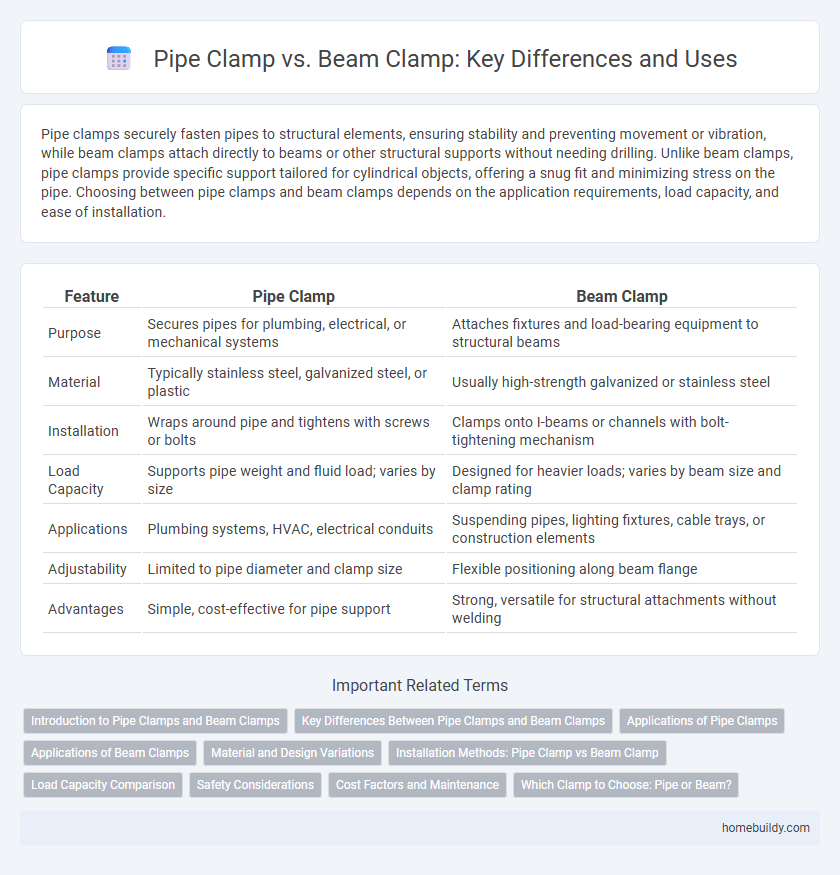Pipe clamps securely fasten pipes to structural elements, ensuring stability and preventing movement or vibration, while beam clamps attach directly to beams or other structural supports without needing drilling. Unlike beam clamps, pipe clamps provide specific support tailored for cylindrical objects, offering a snug fit and minimizing stress on the pipe. Choosing between pipe clamps and beam clamps depends on the application requirements, load capacity, and ease of installation.
Table of Comparison
| Feature | Pipe Clamp | Beam Clamp |
|---|---|---|
| Purpose | Secures pipes for plumbing, electrical, or mechanical systems | Attaches fixtures and load-bearing equipment to structural beams |
| Material | Typically stainless steel, galvanized steel, or plastic | Usually high-strength galvanized or stainless steel |
| Installation | Wraps around pipe and tightens with screws or bolts | Clamps onto I-beams or channels with bolt-tightening mechanism |
| Load Capacity | Supports pipe weight and fluid load; varies by size | Designed for heavier loads; varies by beam size and clamp rating |
| Applications | Plumbing systems, HVAC, electrical conduits | Suspending pipes, lighting fixtures, cable trays, or construction elements |
| Adjustability | Limited to pipe diameter and clamp size | Flexible positioning along beam flange |
| Advantages | Simple, cost-effective for pipe support | Strong, versatile for structural attachments without welding |
Introduction to Pipe Clamps and Beam Clamps
Pipe clamps securely fasten pipes to structural supports, offering adjustable sizes and strong grip for plumbing, electrical, and mechanical applications. Beam clamps attach directly to steel beams or structural members, providing quick, tool-free installation without drilling. Both clamps optimize support and alignment but differ in application and mounting method, with pipe clamps designed for pipe fastening and beam clamps for structural anchoring.
Key Differences Between Pipe Clamps and Beam Clamps
Pipe clamps secure pipes by gripping the pipe circumference, ensuring stable support for plumbing and mechanical systems, while beam clamps attach directly to structural beams, offering flexible anchoring points without penetrating the beam. Pipe clamps typically accommodate specific pipe diameters with cushioned lining to prevent damage, whereas beam clamps use adjustable bolts or screws to firmly grip H-beams or I-beams of varying sizes. The primary difference lies in their application: pipe clamps focus on pipe stabilization, and beam clamps provide structural attachment for fixtures or conduits.
Applications of Pipe Clamps
Pipe clamps are ideal for securing cylindrical pipes in plumbing, HVAC, and fire protection systems, offering reliable support and easy adjustment. They provide firm grip and vibration resistance in piping installations, making them suitable for both residential and industrial applications. Unlike beam clamps, pipe clamps are specifically designed to accommodate round pipe profiles, ensuring optimal stability in pipe routing and alignment tasks.
Applications of Beam Clamps
Beam clamps are commonly used in industrial and construction settings for securely attaching pipes, conduit, or fixtures to structural steel beams without the need for drilling or welding. Their design allows quick installation and adjustment, making them ideal for temporary or permanent support of electrical, plumbing, and HVAC systems. Unlike pipe clamps that encircle pipes directly, beam clamps provide a robust anchoring point on beams, ensuring structural stability and load distribution in heavy-duty applications.
Material and Design Variations
Pipe clamps are primarily made from galvanized steel, stainless steel, or plastic, designed to securely hold pipes of various diameters with adjustable or fixed rings. Beam clamps feature forged steel or malleable iron construction, engineered to attach directly to steel beams and provide strong load-bearing support without penetrating the structure. Material differences impact corrosion resistance and strength, while design variations influence installation methods and application suitability.
Installation Methods: Pipe Clamp vs Beam Clamp
Pipe clamps attach directly around pipes using bolts or screws, providing secure and adjustable support for various pipe sizes, whereas beam clamps fasten onto structural steel beams or girders using threaded bolts and gripping jaws without requiring drilling. Installation of pipe clamps typically involves encircling the pipe and tightening fasteners to evenly distribute pressure, ideal for maintaining pipe integrity. Beam clamps enable suspending pipes or conduit from overhead structures quickly and non-invasively, suitable for flexible positioning along beams without permanent modifications.
Load Capacity Comparison
Pipe clamps generally offer higher load capacity than beam clamps due to their design, which distributes weight evenly around the pipe surface. Beam clamps are limited by their attachment method to structural beams, often resulting in lower load ratings suitable for lighter loads. Choosing the correct clamp depends on the specific load requirements and structural support conditions of the installation.
Safety Considerations
Pipe clamps provide secure attachment points for pipes, minimizing movement and reducing stress on the pipe system, which enhances overall safety. Beam clamps, while useful for attaching to structural elements like I-beams, require precise installation to avoid slipping or damage to the beam, posing potential safety risks if improperly used. Choosing the appropriate clamp based on load capacity and installation environment is critical to ensuring structural integrity and preventing failures.
Cost Factors and Maintenance
Pipe clamps generally incur lower initial costs compared to beam clamps due to simpler materials and manufacturing processes. Maintenance expenses for pipe clamps tend to be minimal, as their design reduces wear points and allows for easy inspection and replacement. Beam clamps, while often pricier upfront, may require more frequent maintenance to ensure secure attachment to structural beams, increasing long-term operational costs.
Which Clamp to Choose: Pipe or Beam?
Pipe clamps provide a secure hold around cylindrical pipes, making them ideal for plumbing, electrical conduit, and HVAC installations, whereas beam clamps attach directly to structural beams and are preferred for supporting heavy loads without the need for drilling. Choosing between a pipe clamp and a beam clamp depends on the specific application requirements, such as the type of load, the material being fastened, and the need for adjustability or repositioning. Pipe clamps offer precise pipe alignment and vibration support, while beam clamps excel in distributing load across structural steel frameworks safely.
Pipe clamp vs Beam clamp Infographic

 homebuildy.com
homebuildy.com